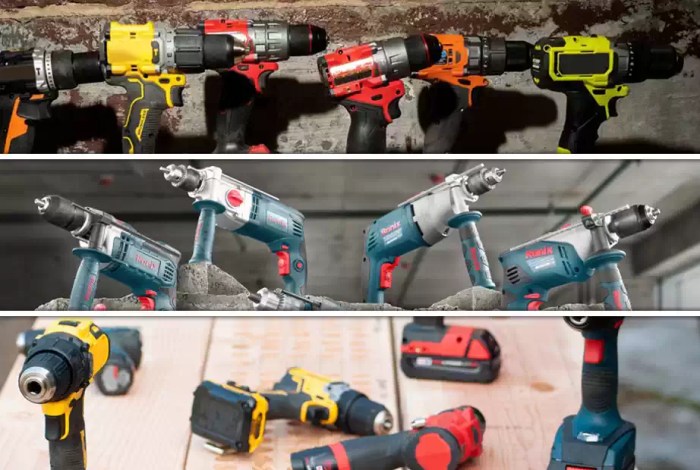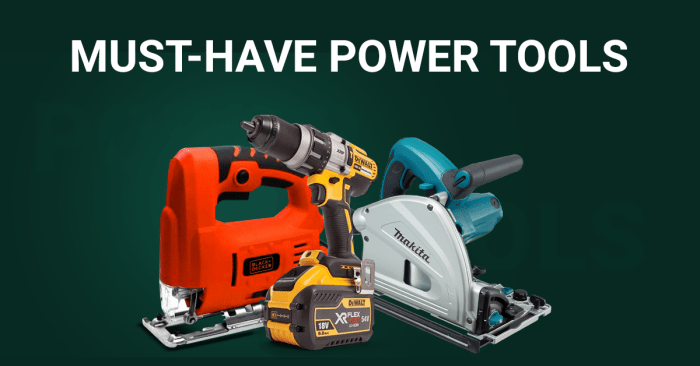Power Tools: DIY Essentials for Homes and Professionals unlocks the secrets to mastering home improvement and professional projects. From tackling simple repairs to complex construction tasks, the right tools make all the difference. We’ll explore the diverse world of power tools, comparing hand-held marvels to stationary powerhouses, and emphasizing crucial safety measures. This guide covers everything from essential DIY tools to professional-grade powerhouses, along with expert maintenance tips and advanced techniques for achieving top-notch results.
Get ready to dive deep into the fascinating world of power tools. We’ll cover everything from the basics to advanced techniques, helping you choose the right tools for your needs, whether you’re a seasoned DIY enthusiast or a budding professional. We’ll also discuss essential maintenance and safety precautions to keep you safe and your tools in top condition.
Introduction to Power Tools
Power tools are indispensable in both DIY projects and professional applications. From fixing leaky faucets to constructing intricate structures, these tools streamline tasks, boost efficiency, and deliver results beyond what manual labor can achieve. Their versatility extends across various industries, making them an essential component in the modern world. Understanding the diverse types and their appropriate applications, coupled with adherence to safety precautions, is paramount for successful and safe use.
Different power tools cater to distinct needs. Hand-held tools, like drills and saws, offer maneuverability for a variety of tasks. Stationary power tools, on the other hand, are designed for specific applications, providing greater power and precision for repetitive or larger-scale projects. This distinction in design directly impacts the tool’s utility and the user’s experience.
Carpentry Power Tools
For carpenters, precision and control are paramount. The tools must be both powerful and maneuverable. Key tools include:
- Planers: Essential for smoothing and shaping wood. Professional planers have higher power outputs for faster and more efficient planing, often capable of handling significantly larger volumes of wood compared to DIY models.
- Table Saws: Used for precise crosscutting and mitering of wood. Professional table saws offer larger tables and more powerful motors, enabling the precise cutting of larger pieces of wood or more complex designs, exceeding the capacities of DIY models.
- Jointers: Used for creating perfectly flat and smooth edges on wood. Professional jointers are equipped with more robust components and advanced features for extended use, compared to DIY models which often struggle with consistent precision on a large scale.
- Routers: Used for creating intricate designs and curves on wood. Professional routers are more powerful, allowing for more complex designs and consistent quality compared to DIY routers, particularly when working with multiple layers or different wood types.
Electrical Work Power Tools
Electrical work demands tools designed for safety and precision. Key tools include:
- Drill Drivers: Essential for installing electrical components. Professional drill drivers offer higher torque and speed for driving screws and bolts in various materials, especially those with different thicknesses, and can withstand frequent use, while DIY models may struggle with heavier materials or constant usage.
- Impact Drivers: Used for driving screws and fasteners quickly and efficiently. Professional models offer higher impact force for tougher fastening tasks and provide more consistent power compared to DIY impact drivers, which may not have the same level of durability.
- Wire Strippers: Used for safely and accurately stripping insulation from wires. Professional-grade wire strippers are typically more precise and efficient, essential for maintaining a high standard of electrical work.
Professional vs. DIY Tools: Key Differences
Professional-grade power tools are designed for sustained, high-intensity use. They feature higher-quality materials, stronger motors, and more robust construction, enabling professionals to handle demanding tasks efficiently. DIY tools, while suitable for occasional use, may not have the same level of durability or power for constant professional use. The difference in performance often translates to the ability to complete tasks in a more efficient manner, potentially saving significant time.
Professional Power Tool Brand Comparison
| Brand | Strengths | Weaknesses |
|---|---|---|
| Brand A | High power, long-lasting, precision cutting, and enhanced durability, resulting in higher-quality finished products | High price, may require specialized maintenance |
| Brand B | Affordable, easy maintenance, suitable for occasional use | Lower power, shorter lifespan, less precision in cutting, potentially compromising the quality of the final product |
| Brand C | Good balance between power and affordability, suitable for a wide range of tasks | Moderate durability, slightly less powerful compared to Brand A |
Power Tool Maintenance and Safety
Power tools are essential for DIY projects and professional work, but their lifespan and performance depend heavily on proper maintenance and safety protocols. Neglecting these crucial aspects can lead to costly repairs, accidents, and even injuries. This section will delve into the vital steps for keeping your power tools in top condition and ensuring a safe working environment.
Regular maintenance is not just about prolonging the life of your tools; it’s about preventing potential hazards. By following these procedures, you can significantly reduce the risk of accidents and ensure optimal performance. Proper maintenance also saves money in the long run by minimizing costly repairs.
Examples of How Accessories Enhance Tool Performance
Accessories can transform a tool’s capabilities. Consider the difference a high-quality wood blade makes for a circular saw, allowing for clean, smooth cuts with less effort.
- Circular Saw: Using a carbide-tipped blade for cutting metal, rather than a standard wood blade, drastically improves cutting speed and reduces the risk of blade breakage.
- Drill: Using a countersink bit creates a pre-drilled hole for screws, which improves screw alignment and prevents them from stripping the wood.
- Impact Driver: Using the right driver bit reduces the chance of stripped screws, and increases the speed of assembly.
Comparing Different Brands and Types of Accessories
Different brands offer various levels of quality and performance. Research and compare based on material, construction, and reviews.
- Quality Materials: High-quality materials, such as carbide-tipped blades or hardened steel bits, are essential for durability and performance.
- Ergonomics: Consider the ergonomic design of the accessory to ensure comfortable use.
- Brand Reputation: Research reputable brands known for their quality and reliability.
- Cost-Effectiveness: Compare the price of different accessories to determine the best value for your needs.
Power Tool Brands and Reviews

Source: ronixtools.com
Choosing the right power tool can be the difference between a smooth DIY project and a frustrating, time-consuming ordeal. Understanding the strengths and weaknesses of various brands, and reading detailed reviews, is crucial for making informed decisions. This section delves into the world of power tool brands, highlighting popular choices, examining their reputations, and offering valuable insights to help you select the perfect tools for your needs.
Popular Power Tool Brands and Their Reputations
Different brands have cultivated distinct reputations over time, often based on factors like build quality, performance, and customer service. Bosch, for example, is renowned for its durability and wide range of tools, suitable for both DIY enthusiasts and professional contractors. Milwaukee, on the other hand, is highly regarded for its robust construction and advanced features, often favored by professionals demanding top-tier performance and reliability. DeWalt, known for its user-friendly designs and powerful motors, stands as a strong contender, attracting both DIYers and professionals.
Detailed Reviews of Power Tools from Leading Brands
To help you make the best choices, here are some detailed reviews of power tools from leading brands:
- Bosch Drill/Driver: Known for its smooth operation and comfortable grip, the Bosch drill/driver provides exceptional performance in various applications. Its compact design makes it ideal for tight spaces, and the adjustable speed settings allow for precision control. Commonly praised for its longevity and ease of maintenance, it’s a reliable option for both casual and professional use. Many users cite its impressive torque for its size, making it suitable for a wide range of screw sizes and materials.
- Milwaukee Impact Driver: Milwaukee’s impact drivers are highly sought after for their power and speed. Their robust construction and advanced motor technology result in superior performance, particularly when working with tough materials. A common highlight is the extended runtime, enabling extended use without frequent charging. Their ergonomic design enhances user comfort, even during prolonged periods of use. Professional users often appreciate the reliability and long-lasting performance in demanding situations.
- DeWalt Circular Saw: DeWalt’s circular saws are recognized for their user-friendly design and precise cutting capabilities. The comfortable grip and balanced design enhance control during operation. The adjustable bevel and depth settings provide versatility for various cutting angles and materials. Many reviews mention the saw’s ability to handle a variety of cuts with accuracy and speed. The included accessories are often praised for their quality and suitability for various woodworking tasks.
Factors to Consider When Choosing a Power Tool
Several factors should guide your decision when selecting a power tool. Consider the intended use of the tool. A drill designed for woodworking might not perform as effectively on metal. The power rating is essential; a higher rating typically means a faster and more efficient operation, but it may also correlate with higher noise levels and potential for greater wear and tear. The size and weight of the tool also play a significant role, impacting comfort and usability, especially for prolonged use. The warranty period is a good indicator of the manufacturer’s confidence in the tool’s quality.
Best Values for Different Tool Types, Power Tools: DIY Essentials for Homes and Professionals
Finding the best value often requires a balance between price, features, and performance. For instance, a budget-friendly cordless drill from a reputable brand like Ryobi or Black+Decker can offer decent performance for DIY tasks without breaking the bank. For professional applications demanding higher torque and reliability, investing in a premium brand like Makita or Hitachi, which might command a higher price, can yield long-term savings. Always compare features, read reviews, and consider your specific needs when assessing value.
Conclusive Thoughts

Source: moglix.com
In conclusion, mastering power tools opens up a world of possibilities for both DIY enthusiasts and professionals. From basic home repairs to complex construction projects, the right tools empower you to tackle any task with confidence and precision. We’ve covered the essentials, from choosing the right tools to maintaining them properly. By following these guidelines, you can confidently navigate the world of power tools and achieve impressive results, no matter your skill level. Remember safety first, and always prioritize proper maintenance for optimal performance and longevity.